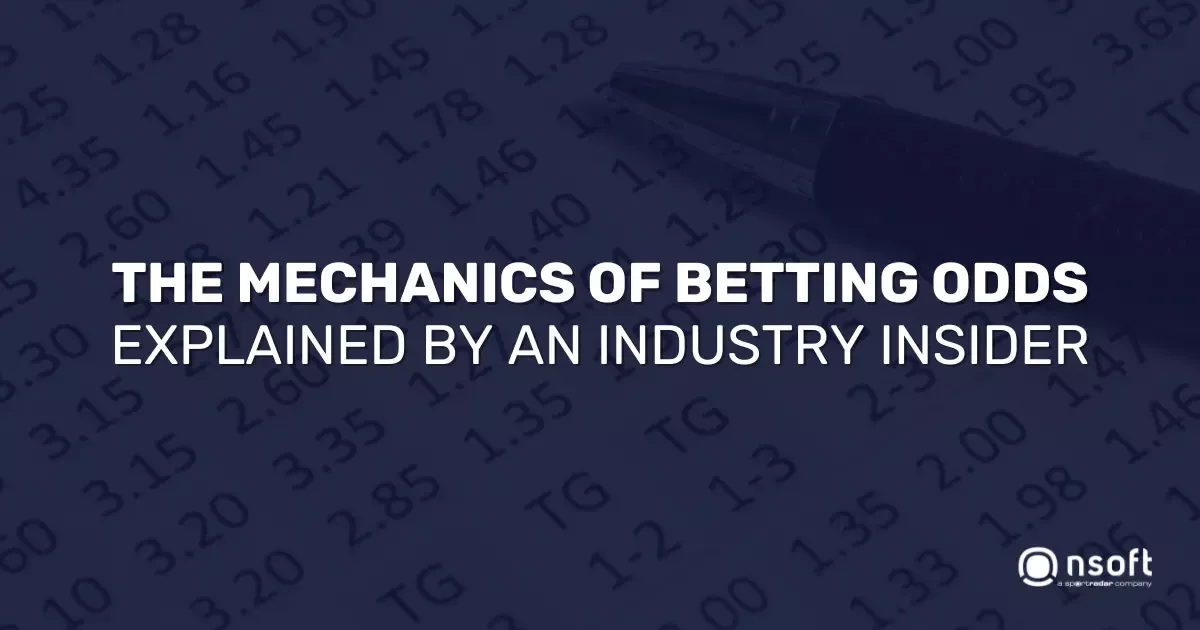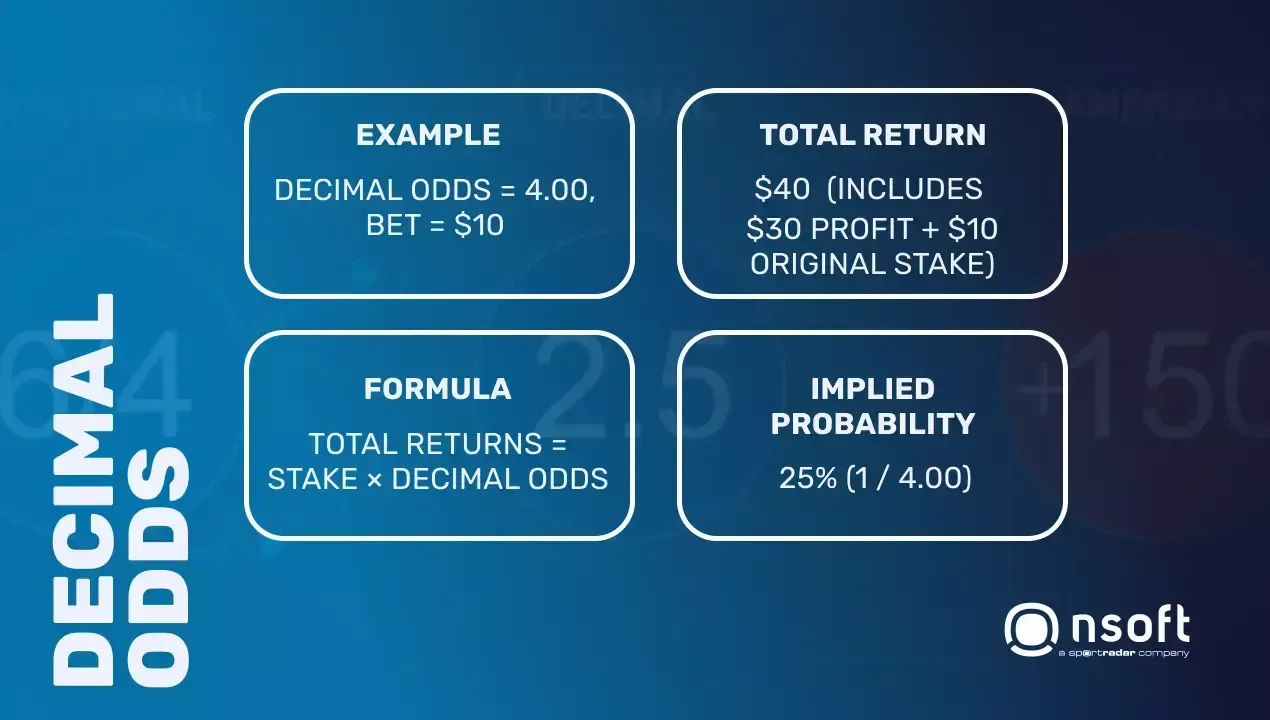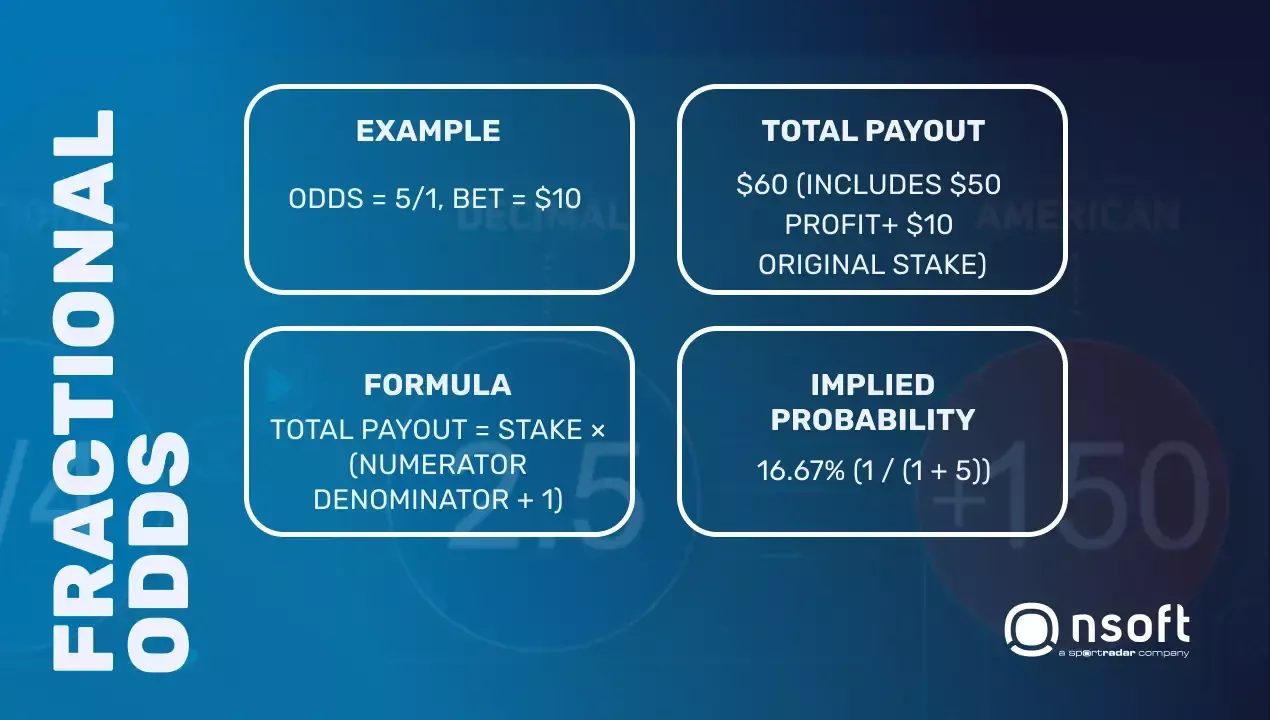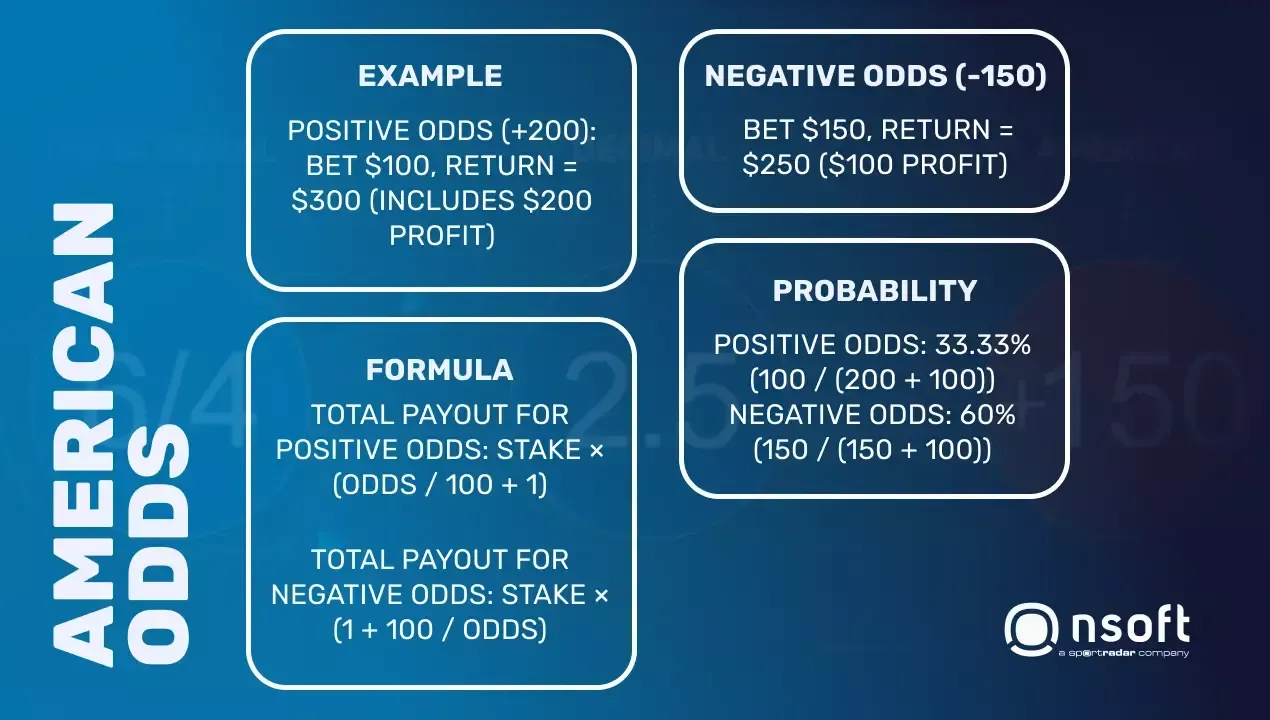Interviews & Editorials
The Mechanics of Betting Odds Explained by an Industry Insider

As the Head of Trading at NSoft, I’ve seen my fair share of numbers, odds, and the occasional furrowed brow trying to make sense of them. So if the odds look hieroglyphics to you, you're in the right place. Let's unpack these numbers and get a clear view of how the world of betting odds really operates.
How Do Betting Odds Work? #
Let’s say you're at a racetrack, eyeing the sleek horses lining up.
Betting odds, simply put, are the mathematically calculated chances of each horse winning the race, translated into a format that tells you how much money you could win if you bet on them.
Whether they're displayed as fractional, decimal, or moneyline values, odds are your key to understanding who the favorites and underdogs are in any contest.
Decimal Odds #

The simplest of all, and widely used in Europe, Australia and Canada, decimal odds tell us what we’d get back for each dollar we wager—including our initial stake.
Calculating the potential take-home looks like this: Total returns = Stake × Decimal odds. So, if the decimal odds are 4.00 and we bet $10, we could win $40 ($10 bet x 4.00 odds = $40 total return). This includes our original $10 bet plus $30 profit.
To find out the implied probability of these odds, we simply take the reciprocal of the decimal odds: Implied probability = 1 / 4.00 = 0.25 or 25%. This tells us the likelihood, in percentage, of our bet winning according to the bookmaker.
Fractional Odds #

Popular in the UK and Ireland, these represent the ratio of the profit won to the stake. Mathematically, it looks like this: Total payout = Stake × ( Numerator/Denominator + 1 ).
So, if we see odds of 5/1 (or "five to one"), it means for every $1 we wager, we win $5 if our bet hits the mark. So, slapping down $10 would win us $50, bringing us a total of $60 back with our stake.
Curious about the chances? The probability is calculated by dividing the denominator by the sum of the numerator and denominator: Implied probability = 1 / 1 + 5 = ⅙ ≈16.67%. Low percentage, high excitement!
American Odds #

In American (or moneyline) odds, front-runners are denoted with a minus (-) and underdogs with a plus (+). Here, betting on the favorite (often referred to as "chalk" because they're a safe draw on the bookie's board) means lower payouts compared to the riskier underdogs. Positive numbers indicate how much we’d win with a $100 bet, while negative shows how much we need to bet to win $100.
The payout calculations look like this:
- Total payout for positive odds = Stake × ( Odds / 100 + 1 )
- Total payout for negative odds = Stake × ( 1 + 100 / Odds )
For example, +200 means we win $200 on a $100 bet (total return $300), while -150 means we need to bet $150 to win $100 profit (total return $250).
Here’s how the math pans out:
- Positive: Probability = 100 / Odds + 100
- Negative: Probability = ∣Odds∣ / ∣Odds∣ + 100
So, odds of +200 imply a probability of 100/200+100 ≈ 0.3333 or 33.33%, and -150 implies 150 / 150 + 100 = 0.60 or 60%.
How Are They Set? #

Alright, we have a football game coming up. Traders start with a base of hard data—player stats, team performance, past matchups and other critical factors. This helps us calculate the “true odds”—straight-up math showing the chances of different outcomes.
Let’s say:
Team A’s winning probability: 70%
Team B’s winning probability: 30%
The simplest odds (without the bookmaker's margin) would be calculated as:
Decimal odds for Team A: 1 / 0.70 = 1.43
Decimal odds for Team B: 1 / 0.30 = 3.33
This means that if you bet $100 on Team A and they win, you get $143 back ($43 profit). If you bet $100 on Team B and they win, you get $333 back ($233 profit).
To ensure profit regardless of the outcome, we adjust these odds by adding a margin. After the margin, you might see something like:
Adjusted decimal odds for Team A: 1.40
Adjusted decimal odds for Team B: 3.10
But as bets pour in and money stacks on Team A, we might move the odds slightly to make Team B more attractive. These "implied odds" still follow probability but are fine-tuned to balance the bets and keep the house in good shape.
Here’s how they might adjust:
Lower Team A’s odds slightly: From 1.40 to 1.38
Increase Team B’s odds slightly: From 3.10 to 3.20
Adjustments also respond to real-time developments right until the last whistle. For example:
Injuries: If a key player from Team A gets injured, their odds might lengthen (e.g., from 1.38 to 1.45), and Team B’s odds might shorten (e.g., from 3.20 to 3.00).
Weather conditions: Say it starts raining heavily, which historically impacts Team A’s performance negatively; the odds may shift to reflect this new information.
Questions I Get Asked a Lot #
Once people find out I'm a trader at a sports betting software company, the questions start flying faster than a fastball in the World Series. Here are some of the most interesting ones I get.
1. How can odds change after I've placed a bet?
The world of sports doesn't freeze the moment you place your bet. Odds fluctuate based on new information or betting trends, but don't worry—your bet is locked in at the odds you agreed to.
2. Why are odds different across betting sites?
Each bookmaker has its own team of experts and algorithms, leading to slightly different predictions. Plus, they might be targeting different types of bettors or reacting differently to how bets are placed.
3. Why do some sports have more volatile odds than others?
Sports with fewer scoring opportunities, like soccer or hockey, often have more volatile odds due to the significant impact a single goal can have. In contrast, sports like basketball with high scoring tend to have less volatile odds, barring major news or injuries.
4. Do weather conditions really affect betting odds?
Absolutely. In outdoor sports, conditions like rain, wind, or extreme heat can significantly impact the game's dynamics and, consequently, the odds.
5. What does it mean when odds are shortening or lengthening?
Imagine a seesaw. If more people think an outcome will happen (shortening), that side of the seesaw goes down. If confidence wanes (lengthening), it goes up.
6. Are odds better live or pre-game?
It depends on the bettor's strategy and what they’re betting on. Live betting offers dynamic odds that can be exploited, while pre-game betting provides stability.
7. Can I predict changes in odds?
It’s tough but not impossible. Keen observers of a sport might anticipate shifts by keeping an eye on news, player conditions, and market sentiment.
8. What does a Pick’em mean?
This is basically us traders saying "You pick 'em, because we sure can't." There’s no clear favorite or underdog in a game. No odds, no spreads—it's just your call on who wins.
9. Is there such a thing as a 'safe bet'?
In betting, there's no such thing as a 100% safe bet, that's a common misconception. Even heavy favorites can lose. It's all about having fun, as well as assessing risks and potential rewards with a bit of gambling mathematics.
10. Can you make a living off sports betting?
The short answer is it's tough. It requires an immense amount of research, discipline, and an understanding of risk management. It's not for the faint-hearted and definitely not a guaranteed paycheck.
11.Do you ever bet yourself?
Nice try! While we're swimming in data and insights, there's a strict policy against betting on games we're involved with. It's all about keeping the game fair and square.
And that wraps up my breakdown of the core component of betting industry—betting odds. Those once cryptic numbers should now start to make a lot more sense. And for even more insights, be sure to check out my A-Z betting glossary.
Tags:
Related Articles
21.11.2024.
Myth-Busting: 10 Common Misconceptions About Betting Odds
Betting odds are misunderstood by even the most seasoned bettors. This post busts 10 common myths with real-world examples and insider knowledge, straight from someone who’s been setting the numbers for over 20 years.
Learn more
Interviews & Editorials
12.12.2023.
10 Tried and True Tactics for Success in the Betting Industry
Discover the top ten strategies for success in betting and iGaming. From innovative platform integration to AI-driven retail insights, this blog reveals how to excel in the dynamic world of betting.
Learn more
Interviews & Editorials
28.09.2023.
eSports & Betting: Transforming Digital Gaming Landscape
Explore the dynamic intersection of eSports and betting. Dive into its transformative impact, from record-breaking viewership to the challenges and opportunities reshaping the digital gaming landscape.
Learn more
Didn’t Find What You’re Looking For?
Our team will be happy to guide you through our products and services.
Contact us